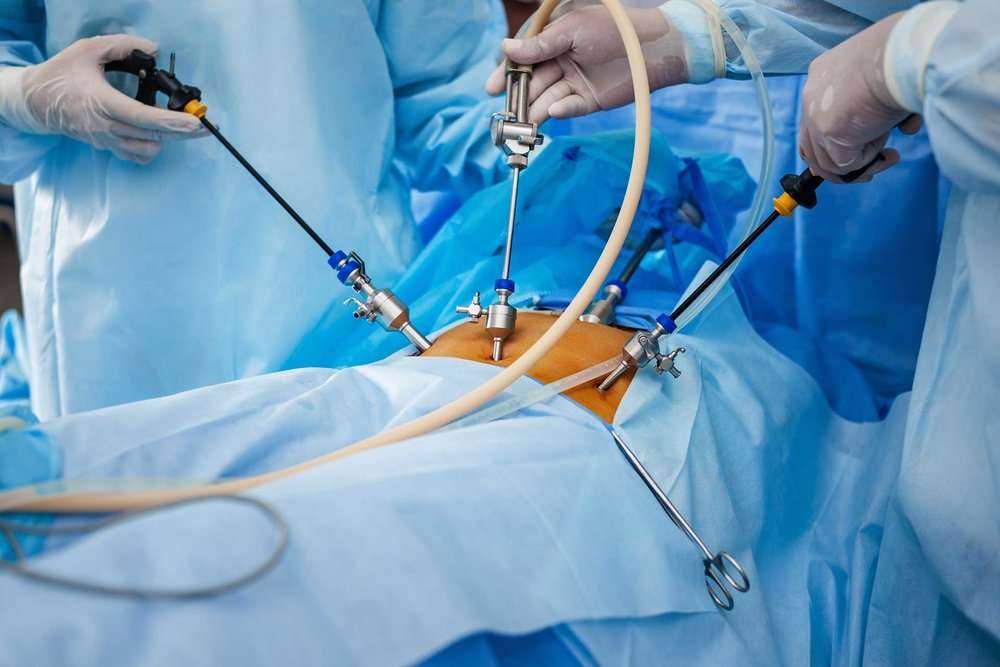Key Takeaways
-
Understand Your Options: Bariatric surgery includes diverse procedures like Sleeve Gastrectomy, Roux-en-Y Gastric Bypass, and Adjustable Gastric Band, each with unique benefits and risks, as surgical intervention for long-term weight loss surgeries involving the main stomach.
-
Consult a Specialist: Speak with a healthcare provider to determine which bariatric surgery, such as gastric sleeve or other surgical procedures, is most suitable for your specific health needs and weight loss goals.
-
Prepare Thoroughly: Proper preparation, including lifestyle changes and medical evaluations, is crucial for a successful surgical intervention and recovery.
-
Post-Surgery Commitment: Long-term success after surgical intervention requires a commitment to dietary changes, regular exercise, and follow-up medical care to improve outcomes.
-
Risk Awareness: Be aware of potential risks and complications associated with each procedure, including open surgery and other operations, to make an informed decision based on health information and outcomes.
-
Support System: Building a strong support system of healthcare professionals, family, and friends can significantly improve your recovery, symptoms, and long-term outcomes after open surgery or operations, and prevent weight regain.
Understanding Bariatric Surgery
Definition and Role
Bariatric surgery helps treat severe obesity. It involves altering the digestive system, including the small intestine, to aid in substantial weight loss and improve outcomes, though it may cause nausea and vomiting. This procedure is often recommended for individuals who have not succeeded with diet and exercise alone to improve outcomes. It can also improve related health conditions like diabetes, high blood pressure, sleep apnea, nausea, and vomiting.
Evolution of Procedures
Bariatric surgery has evolved over decades. The first procedures began in the 1950s. Since then, techniques have improved significantly. Today’s surgeries are safer and more effective. Minimally invasive methods like laparoscopic surgery reduce recovery time. These advancements make the procedures accessible to a broader range of patients.
Safety Improvements
Modern bariatric procedures are much safer than earlier versions. Surgeons now use better tools and techniques. They also follow strict guidelines to minimize risks. Complications like infections or bleeding have decreased considerably. Patients benefit from shorter hospital stays and quicker recoveries.
Quality of Life Benefits
Patients often see an improved quality of life after bariatric surgery. Many find it easier to engage in physical activities they once avoided. Everyday tasks become less challenging as they lose excess weight. Emotional well-being also improves, leading to higher self-esteem and confidence.
Longevity Post-Surgery
Bariatric surgery can extend life expectancy for many patients. Studies show that those who undergo these procedures live longer than those who do not seek surgical help for severe obesity. Reduced risks of heart disease, stroke, and certain cancers contribute to this increased longevity.
Sleeve Gastrectomy Explained
Surgical Process
In a sleeve gastrectomy, surgeons remove about 80% of the stomach. They create a small, tube-like stomach pouch. This new gastric sleeve limits food intake by reducing the stomach’s capacity.
The surgery involves making several small incisions in the abdomen. Through these incisions, surgical tools and a camera are inserted. The surgeon then removes the main stomach portion and staples the remaining part to form the new pouch.
Benefits
Sleeve gastrectomy offers significant benefits. One major benefit is weight loss. Patients often lose 60-70% of their excess weight within two years.
Another benefit is improved health. Many people experience better control over conditions like diabetes, high blood pressure, and sleep apnea after surgery.
Irreversible Nature
This procedure is permanent. Once performed, it cannot be reversed because most of the stomach is removed permanently.
Potential for Reflux
One potential downside is increased reflux. Some patients may develop or worsen acid reflux after surgery.
Roux-en-Y Gastric Bypass Insights
Small Stomach Pouch
Gastric bypass surgery involves creating a small stomach pouch. Surgeons use staples to make this new stomach about the size of an egg. This drastically reduces the stomach’s capacity.
The smaller pouch limits food intake. Patients feel full after eating a small amount of food. This helps in reducing overall calorie consumption.
Intestine Bypass
Surgeons reroute part of the small intestine during this procedure. They connect the new stomach directly to a lower section of the intestine. This bypasses a significant portion of the digestive tract.
Bypassing part of the intestine alters nutrient absorption. The body absorbs fewer calories and nutrients from food. This contributes to weight loss.
Dual Impact
Roux-en-Y gastric bypass has a dual impact on weight loss. It reduces food intake by shrinking the stomach size. It also changes how nutrients are absorbed by bypassing part of the intestine.
This combination is highly effective for substantial weight loss. Patients often lose 60-80% of their excess weight within two years.
Advantages
The benefits of gastric bypass surgery are significant:
-
Substantial weight loss: Patients experience rapid and long-term weight reduction.
-
Disease remission: Many patients see improvements in obesity-related conditions like type 2 diabetes, high blood pressure, and sleep apnea.
-
Improved quality of life: Weight loss can lead to increased mobility and better mental health.
Studies show that up to 85% of patients with type 2 diabetes achieve remission after surgery. Blood pressure levels also improve significantly in many cases.
History
The history of gastric bypass surgery dates back to the 1960s. Drs. Edward Mason and Chikashi Ito first performed it in 1967 at the University of Iowa Hospitals and Clinics.
Since then, techniques have evolved significantly. Laparoscopic methods introduced in the 1990s made surgeries less invasive with quicker recoveries.
Adjustable Gastric Band Overview
Concept
An adjustable gastric band is placed around the upper part of the stomach. This creates a small pouch that limits food intake. The band is made of silicone and can be tightened or loosened.
Personalized Restriction
The adjustability allows for personalized restriction. Doctors can add or remove saline from the band through a port under the skin. This controls the size of the opening to the rest of the stomach.
Weight Loss
Patients lose weight gradually over time. The smaller stomach pouch helps them feel full sooner. Eating less leads to significant weight loss over months and years.
Lower Risk Profile
Adjustable gastric bands have a lower risk profile compared to other bariatric surgeries. There are fewer complications during surgery and recovery.
Reversibility
One key advantage is reversibility. Unlike other procedures, surgeons can remove the band if necessary. This makes it a safer option for many patients.
Biliopancreatic Diversion with Duodenal Switch
Stomach Reduction
The first part of this procedure involves reducing the stomach size. Surgeons create a smaller stomach pouch by removing a large portion of the stomach. This new, smaller vertical pouch restricts food intake. Patients feel full after eating less food.
This reduction helps in controlling hunger and calorie intake. The procedure significantly limits how much one eats.
Intestinal Bypass
The second component is the intestinal bypass. Surgeons reroute a long segment of the small intestine. They connect it to the newly created stomach pouch. This bypasses a significant portion of the digestive system.
By skipping most of the small intestine, fewer calories and nutrients are absorbed. This malabsorptive process leads to substantial weight loss.
Weight Loss Benefits
BPD-DS offers significant weight loss benefits. Patients can lose up to 70% of their excess weight within two years post-surgery. The extensive intestinal bypass plays a crucial role in this outcome.
This surgery improves metabolic conditions such as type 2 diabetes and high cholesterol levels. Many patients experience remission from these conditions due to altered digestion and nutrient absorption.
Nutritional Deficiency Risks
Despite its benefits, BPD-DS carries higher risks of nutritional deficiencies compared to other bariatric surgeries. The extensive bypass means that essential vitamins and minerals are not adequately absorbed.
Patients need lifelong vitamin and mineral supplements to avoid deficiencies like anemia, osteoporosis, and protein malnutrition. Regular follow-ups with healthcare providers ensure proper monitoring and management.
Complexity
This surgery is complex and requires experienced surgeons for successful outcomes. The dual nature of the procedure—combining restrictive and malabsorptive elements—makes it technically demanding.
Due to its complexity, patients must undergo thorough preoperative evaluations to determine if they are suitable candidates for BPD-DS.
SADI-S Procedure Overview
Newer Procedure
The Single Anastomosis Duodeno-Ileal bypass with Sleeve Gastrectomy (SADI-S) is a newer bariatric surgery. It combines aspects of the sleeve gastrectomy and duodenal switch. Introduced in recent years, it aims to simplify the surgical process.
Weight Loss Effectiveness
SADI-S has shown significant effectiveness in weight loss. Patients often lose a large percentage of their excess weight. This procedure helps reduce hunger and increases fullness after meals. Studies indicate that patients can achieve substantial weight loss within the first year.
Metabolic Improvement
Beyond weight loss, SADI-S improves metabolic conditions. Many patients see improvements in diabetes and high blood pressure. The procedure enhances insulin sensitivity, leading to better glucose control. These benefits contribute to an overall healthier lifestyle.
Simpler Rerouting
One key feature of SADI-S is its simpler intestinal rerouting. Unlike traditional methods, this procedure involves only one intestinal connection. This single anastomosis reduces surgical time and complexity. It also lowers the risk of complications during surgery.
Efficacy vs Complications
SADI-S balances efficacy and reduced complication rates well. Compared to older procedures like Biliopancreatic Diversion with Duodenal Switch, it has fewer risks. Patients experience less nutritional deficiencies and fewer long-term issues. This balance makes SADI-S an attractive option for many considering bariatric surgery.
Comparing Surgery Benefits and Risks
Weight Loss Effectiveness
Different bariatric surgeries yield various weight loss outcomes. Gastric bypass often results in significant weight loss. Patients may lose up to 70% of their excess weight within two years. Sleeve gastrectomy shows similar success, with around 60% excess weight loss.
SADI-S is another effective procedure. It combines aspects of sleeve gastrectomy and duodenal switch. This method can lead to substantial weight reduction and improvement in related diseases.
Health Improvements
Bariatric surgeries also improve health conditions. Many patients see a decrease in type 2 diabetes symptoms post-surgery. Hypertension and sleep apnea often improve as well.
Gastric bypass has shown excellent results in resolving type 2 diabetes quickly. Sleeve gastrectomy also helps but may take longer for full effect.
Risk Profiles
Every surgery carries risks. Gastric bypass has a higher complication rate compared to other procedures. Possible complications include infections, blood clots, and internal bleeding.
Sleeve gastrectomy has fewer risks but still presents potential issues like leaks or nutritional deficiencies.
SADI-S can have similar complications due to its complex nature. Nutritional deficiencies are more common because of the malabsorptive component.
Complications and Deficiencies
Complications vary by surgery type. Gastric bypass patients might face dumping syndrome, causing nausea and diarrhea after eating high-sugar foods.
Sleeve gastrectomy patients could experience acid reflux or staple line leaks.
Nutritional deficiencies are a concern for all procedures but are more pronounced in SADI-S due to reduced nutrient absorption. Patients need lifelong supplements to avoid deficiencies in vitamins like B12, iron, calcium, and vitamin D.
Patient Selection
Patient selection is crucial for minimizing risks. Not everyone is suited for every type of bariatric surgery.
Doctors evaluate factors such as:
-
Body Mass Index (BMI)
-
Existing medical conditions
-
Previous surgeries
-
Patient’s commitment to lifestyle changes
Personalized treatment planning ensures the best outcomes while reducing complications.
Personalized Treatment Planning
A tailored approach improves success rates significantly. Surgeons consider the patient’s overall health before recommending a specific procedure.
Pre-operative assessments help identify potential risk factors early on. This allows the medical team to plan accordingly and provide necessary support throughout the process.
Preparing for Surgery
Evaluation Process
Patients must undergo a comprehensive evaluation before surgery. This includes medical tests and consultations. Doctors check for medical conditions like diabetes or heart disease. They also review the patient’s weight history.
Psychological assessments are crucial too. These help determine if patients can handle post-surgery changes. A mental health professional usually conducts these evaluations.
Psychological Readiness
Psychological readiness is vital for success. Patients need to understand the lifestyle changes required after surgery. This includes diet, exercise, and long-term follow-up care.
Counseling sessions can help prepare patients mentally. These sessions address fears and expectations about the procedure and recovery.
Lifestyle Changes
Lifestyle changes start before surgery. Patients should begin adopting healthy habits early on. This makes it easier to maintain them post-surgery.
Quitting smoking is essential as it reduces complications during recovery. Alcohol consumption should also be limited or stopped.
Dietary Preparations
Dietary preparations are key to a successful outcome. Patients often meet with a dietitian to plan their new eating habits. The dietitian provides guidelines on what to eat before and after the operation.
Before surgery, patients might need to follow a liquid diet for several days. This helps reduce liver size, making the surgical procedure safer.
Physical Preparations
Physical preparations include starting an exercise routine if possible. Regular physical activity improves overall health and aids in recovery post-surgery.
Doctors may recommend specific exercises tailored to each patient’s condition and ability level.
Recovery and Long-Term Care
Recovery Timeline
Patients usually stay in the hospital for 2-3 days after bariatric surgery. The first week at home should focus on rest and light activity. Walking short distances helps prevent blood clots. Most people return to normal activities within 4-6 weeks. However, heavy lifting should be avoided during this time.
Dietary Management
Lifelong dietary changes are crucial. Patients start with liquids, then move to pureed foods, and finally soft solids over several weeks. Small, frequent meals are best. Protein intake is vital for healing and muscle maintenance. Avoid high-sugar and high-fat foods to prevent complications.
Supplementation Needs
Nutritional supplements are necessary after surgery. Common supplements include:
-
Multivitamins
-
Calcium with Vitamin D
-
Iron
-
Vitamin B12
Regular blood tests help monitor nutrient levels.
Medical Follow-Ups
Regular check-ups with family physicians are essential. These visits track weight loss progress and detect any health problems early. Blood tests assess nutritional status and overall health.
Mental Health Support
Mental health care is important post-surgery. Counseling can help manage emotional changes and maintain motivation. Many patients find support groups helpful for sharing experiences and advice.
Lifestyle Changes
Significant lifestyle changes are needed for long-term success. Regular exercise improves metabolism and aids weight loss maintenance. Aim for at least 30 minutes of moderate activity most days of the week.
Family Support
Family support plays a key role in recovery and long-term care. Loved ones can assist with meal preparation, encourage healthy habits, and provide emotional support during difficult times.
Closing Thoughts
Bariatric surgery offers various options tailored to your unique needs and health goals. Each procedure has its own benefits and risks, making it crucial to consult with your healthcare provider to determine the best fit. By understanding the different types and what they entail, you’re better equipped to make an informed decision.
Ready to take the next step? Start by discussing these options with your doctor. Your journey towards a healthier life begins with knowledge and preparation. Stay committed, follow post-surgery guidelines, and embrace the support available to you. Your future self will thank you!
Frequently Asked Questions
What is bariatric surgery?
Bariatric surgery helps with weight loss by making changes to your digestive system. It includes procedures like sleeve gastrectomy and gastric bypass.
How does a sleeve gastrectomy work?
In a sleeve gastrectomy, about 80% of the stomach is removed. This reduces food intake and helps you feel full faster.
What is the Roux-en-Y gastric bypass?
Roux-en-Y gastric bypass creates a small stomach pouch and reroutes the intestines. It limits food intake and nutrient absorption, aiding weight loss.
Are there risks associated with bariatric surgery?
Yes, risks include infection, blood clots, and nutritional deficiencies. However, benefits often outweigh risks for those struggling with severe obesity.
How should I prepare for bariatric surgery?
Preparation involves medical evaluations, dietary changes, and mental health assessments. Follow your healthcare provider’s guidelines closely.
What is recovery like after bariatric surgery?
Recovery includes hospital stay, gradual diet progression, and regular follow-ups. Full recovery can take weeks to months.
What long-term care is needed post-surgery?
Long-term care involves regular check-ups, nutritional supplements, and lifestyle changes. Maintaining these habits ensures lasting success and health benefits.





